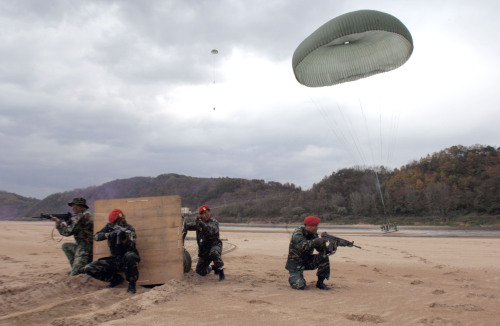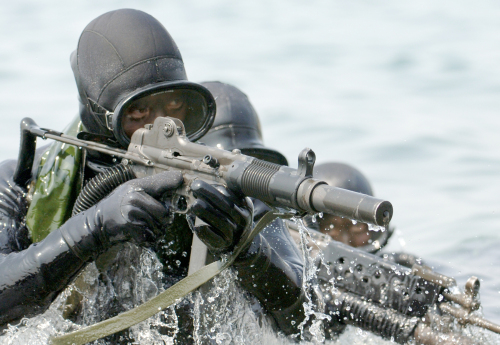South Korea’s elite troops redoubling their efforts to bolster combat capabilities
Despite the notoriously grueling training schedule, Hong Jae-woon, a veteran special warfare troop, is always alert and full of pep to maintain “perfect readiness” against possible North Korean aggression.
Undaunted by the prospect of life-threatening tasks in the case of another armed conflict with North Korea, Warrant Officer Hong, 50, has prided himself on being part of the Combat Control Team since he joined the Air Force three decades ago.
Despite the notoriously grueling training schedule, Hong Jae-woon, a veteran special warfare troop, is always alert and full of pep to maintain “perfect readiness” against possible North Korean aggression.
Undaunted by the prospect of life-threatening tasks in the case of another armed conflict with North Korea, Warrant Officer Hong, 50, has prided himself on being part of the Combat Control Team since he joined the Air Force three decades ago.

“There are, of course, drills that are mentally and physically demanding. However, such difficulties are also part of the training process. Through our strong comradeship and pride, we are tiding over the difficulties,” Hong told The Korea Herald.
“Under our motto of ‘first there, last out,’ we are striving to conduct practical and effective drills to perfectly carry out our missions at a time when the North Korean threats are increasing.”
Hong is one of 20,000 special troops in the 650,000-strong military.
Despite being outnumbered by North Korea’s 200,000-strong special force, the South’s elite troops, better equipped with high-tech military weaponry, have a strong conviction that they could successfully defeat any hostile forces in the case of military clashes.
Over the past few decades, special warfare troops have enjoyed great public support thanks to a series of audacious operations that have successfully saved citizens from home and abroad.
The high-profile operations have included a host of anti-spy operations and the most recent one by the Navy commandos that rescued 21 crewmembers of the chemical freighter Samho Jewelry from Somali pirates in January.
Living up to their reputation as the “most reliable, dedicated elite force,” the special troops in the Army, Navy, Air Force and Marine Corps are now redoubling their efforts to bolster combat capabilities, particularly as peninsular tensions remain high in the wake of the two deadly attacks by the communist state last year.
Navy’s UDT/SEAL
Korea’s group of naval special troops, who recently emerged as national heroes following the anti-piracy rescue operation in the Indian Ocean in January, are officially called “UDT/SEAL.”
UDT stands for Underwater Demolition Team while SEAL represents sea, air and land. As its name reveals, UDT/SEAL troops engage in special operations taking place in all volatile areas on land, in the air and at sea.

In the event of a war, the naval commandos are to infiltrate the enemy’s coastal areas ― ahead of the friendly forces’ amphibious landing operations ― to remove anti-ship mines, underwater weapons, coastal artilleries and radar facilities.
They are also to stage reconnaissance tasks and offer battleground information to their comrades preparing to join them in enemy areas.
“Whether it is an exercise or real war, I always have this conviction that I will definitely defeat the enemy to save our citizens and my comrades. Our unit is maintaining the highest readiness at all times through the strong drills and robust companionship among us,” Lieut. Kim Jin-hyun, 27, said.
The naval special commando unit was established in 1955, two years after the 1950-53 Korean War ended in a truce that has left the two Koreas technically at war to date.
Since its inception, the group has evolved into one of the country’s most formidable forces, undertaking missions to dispose of explosives in 1968, strike targets at sea, in the air and on land in 1976 and a maritime counter-terrorism mission in 1993.
Led by its motto “Nothing is impossible,” the naval special forces have also engaged in a series of maritime search and rescue operations including the one to salvage crewmembers of the Cheonan, which was torpedoed by a North Korean submarine in the West Sea last March.
Becoming a member of the elite group is a truly gruelling process, which includes a 24-week basic training session.
The aspiring UDT members also endure a “hellish week” during which they do a punishing exercise without sleeping for 138 hours. During the week, they also mountain climb with an 85-kilogram rubber boat on their shoulders during the daytime and engage in maritime maneuvers at night.
The Ship Salvage Unit is another naval special warfare group. It comprises of deep-water divers and specializes in salvaging sunken warships and rescuing crewmembers from them.
Army commandos with black berets
“We, battle-ready forces, are full of passion that could melt the snow under this frigid weather. There is no place we cannot go and fight. We are fully trained and ready to take on our missions under any circumstances,” Capt. Yoo Yong-hun, 28, said.
The Army special troops, known for their black berets, operate deep inside enemy regions. There, they carry out reconnaissance missions, destroy key military facilities, capture crucial enemy figures and cause confusion among enemy troops.
During wartime, they can infiltrate enemy areas aboard C-130 and CN-235 transport planes, and special operations aircraft such as MH-47 helicopters.
The first group of the Army special troops was established in 1958 to meet the need for rapid reaction forces and “deep operations troops,” which are aimed at swiftly taking control of enemy territory. The Special Warfare Command was established in 1968.
In addition to a host of operations to deter North Korean provocations, Army special troops have also staged 12 major anti-guerilla operations, including one in Uljin County in 1968 and another in Gangneung in 1996.
Through the operations, which together killed 55 North Korean infiltrators and captured three others, the special troops gained much public trust while deterring further infiltration attempts by the North.
The Army special troops have also put themselves at the vanguard of overseas peace-keeping and relief operations, through which they demonstrated to the world the strength of South Korean troops.
Starting with its dispatch to the Vietnam War from 1964-73, the Army sent its elite soldiers to East Timor from 1999-2003 and Iraq from 2003 through 2008.
It has also deployed the troops to Lebanon since 2007, Afghanistan since 2010 and Haiti since 2010. Most recently, it sent troops to the United Arab Emirates in January where its troops are helping train the Middle East country’s special troops following its request last August.
Of the Army special troops, those belonging to the “707 special-mission unit” are regarded as the most elite warriors. Other then anti-terrorism operations, retaliatory activities and guard missions, they are to carry out unidentified missions in the event of a war.
The Army special troops also carry out all-year-round exercises including maritime and land-based infiltration drills, mountain-climbing exercises, long-distance marches and those in which soldiers must survive freezing temperatures.
Air Force’s CCT/ Marine Special Recon
The Air Force created the small yet strong Combat Control Team in 1978 to meet the need for special troops to help military aircraft safely fly into the enemy areas and accurately drop airborne troops, supplies and other materials into safe zones.
During wartime, the CCT troops are the first to enter enemy areas to secure them before friendly forces come to stage military operations there. They also help guide fighter jets so that they can accurately shoot enemy targets.
They are required to receive intensive training on a variety of military skills concerning the low- and high-altitude drop, maritime, air and land-based infiltrations, military communications, weather forecasting and destruction of enemy facilities.
The Marines special reconnaissance team, which was established in the late 1950s, is to serve as the eyes and ears of the amphibious landing troops. Its troops will first infiltrate into the enemy’s coastal regions to secure the areas and gather operational information there.
Despite the artillery attack on Yeonpyeong Island in November, which killed two Marines and two civilians, the number of applicants for the recon unit has increased.
By Song Sang-ho (sshluck@heraldcorp.com)



















![[Today’s K-pop] BTS pop-up event to come to Seoul](http://res.heraldm.com/phpwas/restmb_idxmake.php?idx=642&simg=/content/image/2024/04/17/20240417050734_0.jpg&u=)